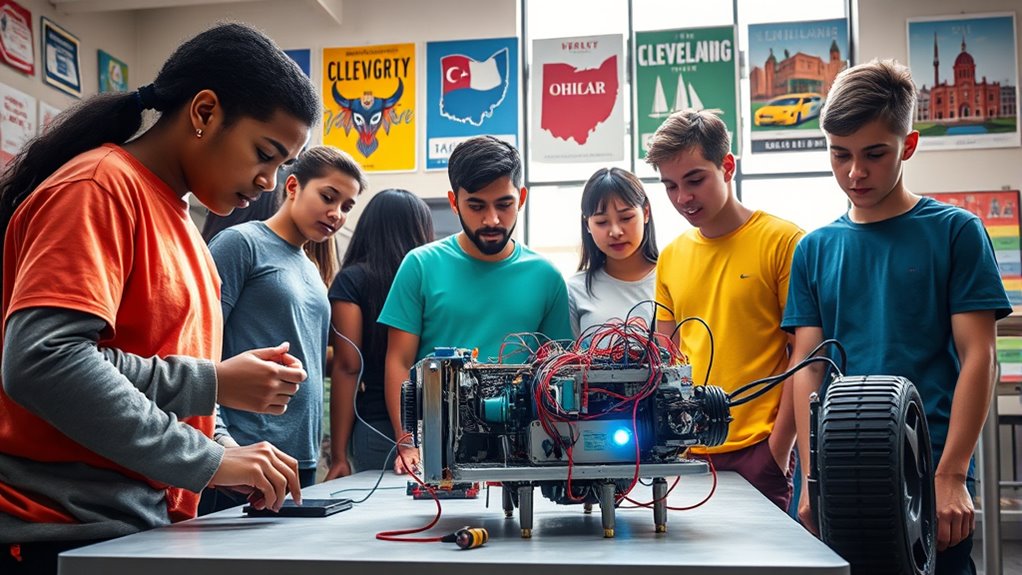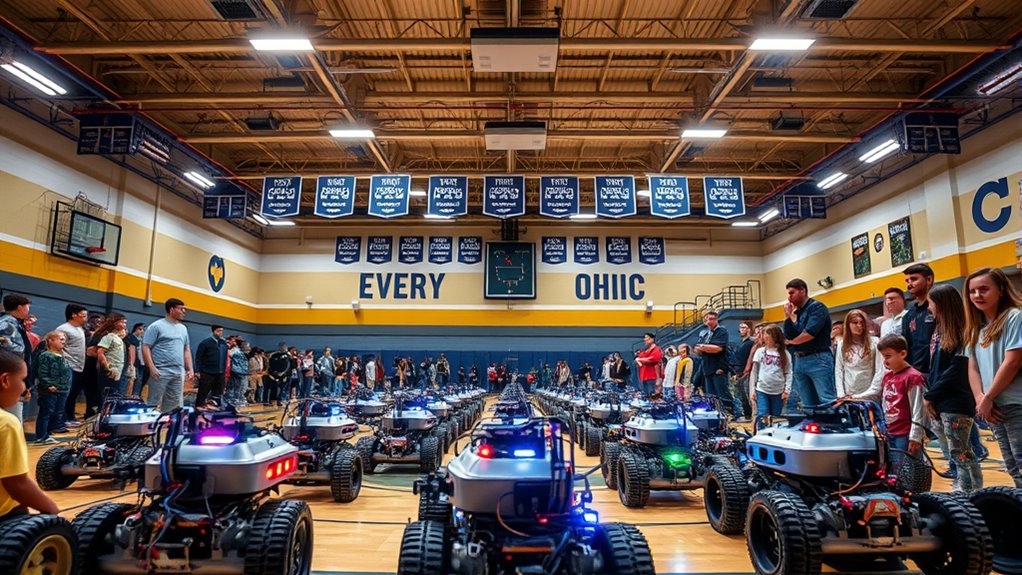What you witnessed in a Cleveland school shows how robotics is transforming Ohio’s future by giving students hands-on STEM experience, building essential skills like teamwork and problem-solving. These programs connect students with industry mentors, foster inclusivity, and prepare them for high-demand tech careers. As they design and compete with robots, they gain confidence and practical knowledge. Continuing this journey reveals how these initiatives can shape Ohio’s economic growth and innovation for years to come.
Key Takeaways
- Cleveland schools’ robotics programs develop critical skills like teamwork, problem-solving, and innovation, preparing students for Ohio’s evolving tech industry.
- Partnerships with organizations like the Great Lakes Science Center provide mentorship and resources, expanding access to STEM education.
- Robotics initiatives create a pipeline of skilled, confident students who receive scholarships and pursue careers in Ohio’s manufacturing and tech sectors.
- Hands-on robotics learning fosters community engagement and demonstrates how experiential education can drive economic resilience.
- Statewide efforts to produce locally made robotics kits and expand programs showcase Ohio’s commitment to future-proofing its workforce.

Robotics programs are transforming Cleveland schools by providing students with hands-on STEM learning and real-world skills. During my visit, I saw how the Cleveland Metropolitan School District (CMSD) actively integrates FIRST Robotics and VEX Robotics into its curriculum and extracurricular activities across multiple schools. These initiatives aren’t just about building robots; they’re about fostering critical thinking, teamwork, and problem-solving. CMSD’s partnership with the Great Lakes Science Center enhances this experience by offering mentorship, curriculum support, and resources, especially targeting underserved students who might not otherwise have access to such opportunities. Watching students collaborate on design challenges and compete in regional events, I realized how these programs ignite passion and confidence in young minds.
The Greater Cleveland FIRST Robotics initiative brings together six district teams, including MC2STEM, Davis Aerospace & Maritime, and an all-girls team, creating an inclusive environment for over 100 students. These teams face intense six-week build seasons, where they design, build, and program robots to meet the challenges of each year’s game. The energy during competitions like the Curiosity Open at the Great Lakes Science Center is palpable, with teams from Northeast Ohio showcasing their skills and creativity. It’s clear that participation in these events boosts not only technical abilities but also soft skills like leadership, communication, and resilience—traits that will serve students well beyond high school. Event and Location Details These programs also promote hands-on STEM learning, which is essential for developing practical skills and understanding complex concepts through direct experience.
What stands out most is how these programs have broader economic and community impacts. Ohio’s Experiential Robotics Platform aims to outfit classrooms statewide with robotics kits, produced locally, which provides students with manufacturing experience and prepares them for careers in Ohio’s growing tech industry. Many FIRST alumni earn scholarships worth millions, opening pathways to higher education and promising careers. As I observed students taking on roles from design to marketing, it became apparent that robotics education nurtures a pipeline of skilled, confident individuals ready to contribute to Ohio’s innovative economy. What I witnessed in Cleveland schools exemplifies how robotics can truly reshape Ohio’s future—empowering students and strengthening communities through hands-on learning and opportunity.
Frequently Asked Questions
How Do Robotics Programs Impact Student Academic Performance Long-Term?
Robotics programs boost your long-term academic performance by enhancing your understanding of STEM subjects and developing hands-on skills. They increase motivation, critical thinking, and problem-solving, which translate into better grades across various subjects like math and science. Longer engagement in these programs correlates with sustained academic improvement, giving you a competitive edge. Plus, robotics fosters collaboration and perseverance, skills that benefit you well beyond the classroom and into your future career.
What Challenges Do Schools Face When Implementing Robotics Curricula?
You face several challenges when implementing robotics curricula. Limited funding means you struggle to buy kits and upgrade infrastructure, especially in under-resourced districts. Teachers often lack proper training and incentives, making it hard to integrate robotics effectively. Curriculum redesign and scheduling conflicts also hinder progress, while disparities in access mean not all students benefit equally. Overcoming these obstacles requires targeted investment, professional development, and systemic support.
Are There Partnerships With Local Industries to Support Robotics Initiatives?
Yes, there are strong partnerships with local industries supporting robotics initiatives. You’ll see manufacturers like Sherwin-Williams collaborating directly with schools to design relevant curricula, while trade groups like the Ohio Manufacturers’ Association align education pathways with industry needs. These partnerships provide hands-on experiences, funding, and access to advanced equipment, ensuring students gain practical skills and a clear pathway to local manufacturing careers. This collaborative effort is shaping Ohio’s robotics and STEM education landscape.
How Accessible Are Robotics Programs for Students From Diverse Backgrounds?
Like a well-oiled machine, Ohio’s robotics programs are increasingly accessible for students from diverse backgrounds. You’ll find initiatives embedded in classrooms, supported by local industry partnerships, and funded through state investments. Programs like FIRST Robotics offer free or low-cost opportunities, especially benefiting underserved communities. With expanded college pathways and inclusive standards, you can confidently step into robotics, knowing Ohio’s efforts aim to bridge gaps and open doors for everyone.
What Training Do Teachers Receive to Effectively Teach Robotics?
You receive extensive training that covers industrial robot programming, troubleshooting, and safety protocols, including courses on FANUC and Yaskawa models. This hands-on instruction equips you with skills to teach robotics effectively, integrating real-world applications and STEM standards. You also learn how to mentor students in competitive robotics and incorporate coding into your curriculum, ensuring you’re prepared to foster students’ technical skills and inspire future careers in automation.
Conclusion
So, next time you see kids tinkering with robots instead of textbooks, don’t worry—they’re just preparing Ohio for a future where humans might finally take a backseat. Who needs traditional education when we can teach machines to do the heavy lifting? Maybe soon, Cleveland’s students will be designing robots to do their chores, leaving us to wonder—are we shaping a smarter workforce or just training for a robot uprising? Either way, progress looks pretty automated.











